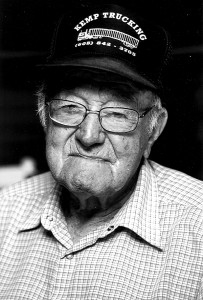
Art Kemp will celebrate his 100th birthday Sept. 10.
The family will host an open house in his honor on Sept. 10 at the Holiday Inn Express in Winner from 2-4 p.m.
Cards can be sent to Kemp at: Art Kemp, 31510 289th St. Colome, S.D. 57528

Art Kemp will celebrate his 100th birthday Sept. 10.
The family will host an open house in his honor on Sept. 10 at the Holiday Inn Express in Winner from 2-4 p.m.
Cards can be sent to Kemp at: Art Kemp, 31510 289th St. Colome, S.D. 57528
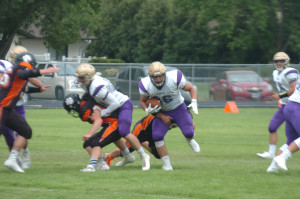
The No. 1 rated Winner High School football team opened the season Friday night with a commanding 46-0 victory over Mobridge-Pollock.
The Warriors scored 38 points in the first half on their way to a shut out.
The Warriors will travel to Cheyenne-Eagle Butte on Friday. CEB has some quick skill athletes and a tall tight end.
This week CEB defeated Bennett County 30-14.
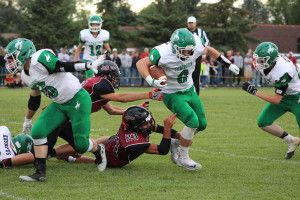
Colome High School football team’s opening game of the season was a thriller as it was a battle of the No. 3 and No. 4 teams in Class 9B.
The Cowboys were on the road as they played Corsica-Stickney. Colome was nipped 16-14 after having the lead in the game.
Colome will travel to Gayville-Volin on Friday.
Winner Lady Warriors volleyball team opened the season with two road trips.
The team was defeated in three sets against Bon Homme. The Lady Warriors lost 15-25, 18-25 and 19-25.
Winner lost in four sets to Miller on Aug. 25.
The Lady Warriors won the first set 25-20 but lost the next three 17-25, 12-25 and 20-25.
The next action for Winner will be Sept. 1 when the Lady Warriors host a triangular with two Nebraska schools. Winner will play Ainsworth at 4:30 followed by Valentine vs. Ainsworth then Winner vs. Ainsworth.
On Sept 6, Winner will host Bennett Co. and Gregory.

The Colome girls volleyball team opened the season on Saturday playing Burke/South Central.
Colome lost 10-25, 18-25 and 19-25.
Colome will travel to Gregory to play in the Gregory Invitational on Sept. 3.

Winner Area boys and girls cross country team won first place at the Winner Invitational on Friday.
The boys scored 13 points for first place with Lyman second and White River, 3rd.
In the girls division, the Lady Warriors were followed by St. Francis for second and Lyman, third.
The Winner Lady Warriors swept the top four places. First place went to Sidda Schuyler with a 21:37.51. She was followed by Sam Schuyler, 2nd, 22:23.35; Chloe Bartels, 3rd, 22.32.59 and Jaclyn Laprath, 4th, 22:45.46.
Aryn Meiners took 6th in 23:56.37 and Megan Blare was 10th in 25:35.08.
The girls team had a perfect score in this meet.
The boys varsity race was won by Aaron Voigt of Gregory in 18:00.05.
Winner was led by Kade Watson who took second in 19:33.90.
Also placing for Winner were Izak Moleterno, 4th, 20:03.97; Andrew Laprath, 7th, 21:15.85; Dawson Phillips, 11th, 21:50.43; Wyatt Turnquist, 14th, 22:35.33.
The next meet for the Winner area team will be Sept. 6 at Scotland.
Matt Hartley of the Winner High School boys golf team competed in the Mobridge-Pollock Invite on July 23. Hartley was the only varsity golfer for Winner. He shot a 53, 57—110.
This was the first meet of the season for the Winner team.
Chamberlain was first with a 314 and Mobridge-Pollock was second with a 356.
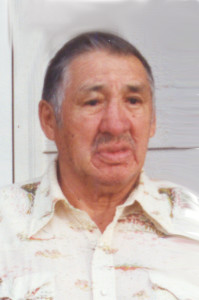
Richard Duane Medicine Eagle Sr. was born in Mosher, SD on June 15, 1929 to William and Ida (Kills Two) Medicine Eagle.
Richard married Geraldine Andrews and made their home in Mosher where for most of his life he worked on the George Schilling farm. He enjoyed playing baseball and was on the 1948 Mosher team that went to the State Tournament in Watertown.
Richard had six children: Eleanor, Shirley, Richard Jr., Doyle, Timothy and Carol.
Richard also had eight siblings all of whom are deceased. George Sr., William, Martin, Eugene, Bernard, Pauline, Matilda and Lucinda.
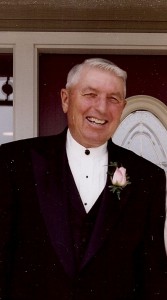
Ivan Frank Vosika was born on February 20, 1934 to Stanley and Ona (Stasney) Vosika. Ivan was raised on the farm near Gregory and lived there all his life. As a young boy, Ivan was stricken with rheumatic fever making school difficult. With the help of his mother reading to him by lamp light, Ivan finished the eighth grade and then later obtained his GED.
Ivan volunteered for military service in February 1954 and was honorably discharged from the Army in February 1956.
Ivan married Shirley (Boes) in September 1962 in Gregory, SD along-side her sister Nola Jean in a double ring ceremony. Together they raised three children, David, Lori, and Dan. Ivan and Shirley enjoyed 54 years together, all on the family farm.
Through long hours and hard work, Ivan and Shirley developed and expanded their farm to include a large dairy and livestock operation. Ivan was an industrious and creative mechanic who had the unique ability to fabricate things on the fly to keep his operation running smoothly. Had health not interfered in his later years, Ivan would still be doing what he enjoyed most, windrowing and baling the hay fields.
In addition to farming, Ivan had many interests. He wasn’t afraid to create and live a dream and be involved. He obtained his pilot license at a young age and purchased his first plane in 1951. For over five decades, Ivan was active with other pilots in Gregory, forming a flying club and giving rides to area children at the numerous hanger parties. He spent countless hours scouting local shelterbelts and abandoned farms by air, searching for old tractors around South Dakota and Nebraska. Many times he would land on a country gravel road, taxi up to the target and inquire about the availability of it. He also flew to many air shows and enjoyed with Shirley many flights to area towns with other flying couples, simply to have breakfast.
During this time, Ivan also became a serious collector of antique John Deere tractors. He took great pleasure in sharing the love of restoration with friends who would spend many hours with him in the tractor shop. He won many awards with his tractors and enjoyed showing them during parades. He attended many tractor flea markets and pulls. He also enjoyed his collection of “retired” family automobiles. Most dear to his heart was his beloved 1960 Chevrolet Impala which he purchased new. It became not only he and Shirley’s courting vessel, but later the family car; and then finally a source of pride and a connection to his earlier years gone by.
Ivan was also active in the community by serving on the Rhoades Township board, the ASC board and was on the Gregory Farmer’s Elevator board of directors for many years. He was a long time member of the American Legion.
Ivan was known to lend a helping hand to his neighbors, friends and family, made many friends in his life adventures and thoroughly enjoyed round table discussions at Mr. G’s in his retired years. And, rarely a Sunday would pass where he didn’t pay a visit to someone known to him who was hospitalized or in assisted living. He was ready with a smile, enjoyed sharing a laugh and was quick witted when least expected.
Ivan enjoyed seeing his four grandkids. They will miss his physical presence but are gifted with knowing grandpa’s influence is ever present about the farm.
Ivan is now in a place of peace playing pitch, drinking coffee and surrounded by his favorite farm dogs. He is reunited with all those who made his life so special, while those left behind treasure the life of Ivan well lived.
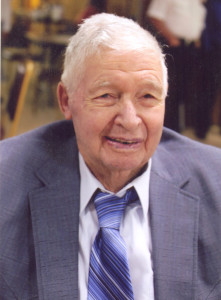
Fred was born on September 23, 1924 to Otho and Mabel (Robertson) Woods on the family farm 11 miles south of Colome. He was the youngest of 8 brothers and 3 surviving sisters. He graduated from Mrs. Irma Painter’s 8th grade class on May 17, 1940 and completed his last year of school as a sophomore in 1941-42. He registered for Selective Service annually from 1942-1950 as required and was classified “Frozen Farm Laborer” and not deployed. He rode the military cattle cars from Colome to Ft. Snelling, MN in May of 1945 and was found “physically fit, acceptable for general military service” but the war effort was winding down by that time and he was not deployed.
He took great pride in his athletic achievements which included Golden Glove Boxing, sprinting in track, and scoring the only touchdown his sophomore year to lead Colome to a 6-0 victory over Winner! He grew up during the 30’s and hunted arrow heads in bowling sand for spending. He also grew up farming with horses before tractors became in Tripp County. He was accomplished cow & horseman. He often commented that “If you take care of the cows, they’ll take care of you”. Fred was one of the first men with registered Angus in Tripp County. Fred had a few odd jobs before settling down with his lovely bride in 1949 which included scooping wheat by hand for his brother Dick in Garden City, KS, where he also moonlighted as a chauffeur driver on evenings and weekends. He also worked for a short time at the Fremont Foundry as a welder in Fremont, NE.